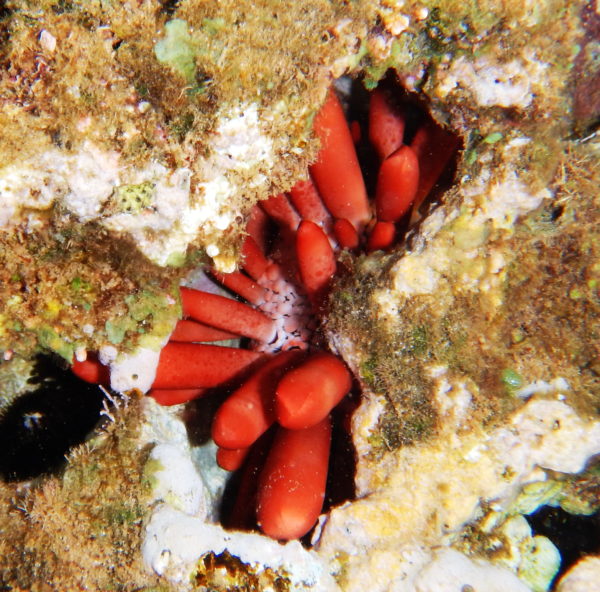Published in the Ocean Watch column, Honolulu Star-Advertiser © Susan Scott
July 8, 2017
Last week when I arrived at one of my favorite snorkeling spots, I found fishermen lined up near the waterline. To avoid their hooks and lines, I had to enter the water far down the beach and swim in an area different from my usual.
It caused me to see red. Not red as in anger, but red as in scarlet.
 A slate pencil sea urchin is tucked into a tight place for a daytime nap.
A slate pencil sea urchin is tucked into a tight place for a daytime nap.
This type of urchin can be found in the Indian and Pacific oceans.
©2017 Susan Scott
The outer reef in this North Shore area takes a beating from the surf every winter, and is therefore riddled with cracks and crevices. Wedged tightly into one of the smaller holes, in about 3 feet of water, was a large, red slate pencil sea urchin.
Slate pencil urchins are found throughout the Indian and Pacific oceans, but they are only abundant in Hawaii’s clear shallow waters. Lucky us. In some island areas these sea urchins decorate the reef like glorious gaping flowers. To see some of Hawaii’s exquisite red sea urchin gardens, click here.
Slate pencil urchins have blunt, paddlelike spines that reminded someone of the chalk sticks people once used to write on slates. Unlike their cousins, the long-spined black sea urchins, or wana, the slate pencil’s blunt spines can’t pierce human skin.
Even so, for the sake of the animal, you don’t want to touch these red beauties. Covering each of the creature’s “pencils” is a thin layer of tissue that inhibits the growth of algae and other marine organisms. Handling these animals, even gently, can damage their natural protection.
At night the slate pencil sea urchin uses its suction-cup tube feet to walk around the reef, scraping up algae with its underside mouth. During the day the creature tucks into reef holes for rest and protection.
[espro-slider id=2424]
Really tucks in. Often the animal looks so crammed into the space with its paddlelike spines pointing every which way, it’s hard to imagine how the urchin got in there and, come dusk, how it will get out.
These creatures are more flexible than they look. The sea urchin can’t bend its spines, but can move them in most any direction because each is attached to the body with a movable ball-and-socket joint.
Red isn’t a common color on the reef. Because the sun’s red wavelength doesn’t penetrate water very far down, red looks red only in shallow water. At about 30 feet deep, red looks brown. Continue to 60 feet and below, and red turns black.
Most slate pencil sea urchins hang out on the top and sides of shallow reefs, displaying their stunning paddles for all to see.
I admit that I get grumpy about fishermen casting into shallow reef areas, because when their lines get stuck, the anglers cut them, leaving yards of monofilament to wrap around coral heads and strangle turtle flippers. This time, though, the shoreline anglers gave me a gift: a new place to see red.